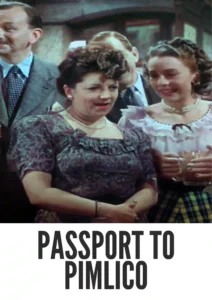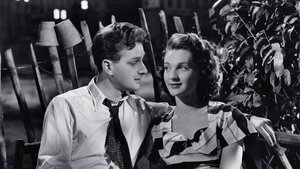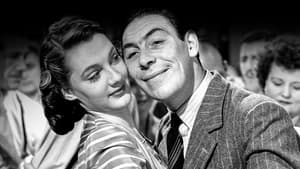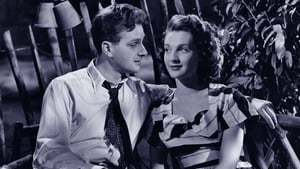Contact: [email protected]
Video Sources 0 Views
- Watch trailer
- Passport to Pimlico


Passport to Pimlico 1949 First Early Colored Films Version
Synopsis
Table of Contents
ToggleReview: Passport to Pimlico (1949) – A Charming and Whimsical Comedy

Introduction
Passport to Pimlico, released in 1949, is a delightful comedy directed by Henry Cornelius that showcases the quintessential British humor and wit. Renowned for its charm, wit, and clever social commentary, this classic film continues to entertain audiences with its whimsical tale of a London neighborhood declaring independence. In this review, we’ll delve into the delightful world of Passport to Pimlico and its enduring appeal in the realm of British cinema.
Check The Full Colorized Movies List
Check Our Colorized Movies Trailer Channel
Understanding Passport to Pimlico (1949): Director, Cast, and Genre
Directed by Henry Cornelius, Passport to Pimlico features a talented ensemble cast, including Stanley Holloway, Margaret Rutherford, and Hermione Baddeley. The film belongs to the comedy genre, known for its lighthearted humor, witty dialogue, and playful satire.
Exploring the World of Passport to Pimlico (1949): Plot and Characters
Passport to Pimlico unfolds in post-war London, where an unexploded bomb reveals an ancient document declaring Pimlico an independent nation. As the residents of this newfound microstate embrace their newfound freedom, they encounter a series of comedic misadventures and bureaucratic challenges. Led by the eccentric Professor Hatton-Jones, the residents of Pimlico embark on a humorous journey to assert their sovereignty and defy the authorities.
The Art of Film Colorization
While Passport to Pimlico was originally filmed in black and white, its early colorized version adds a new layer of vibrancy to its charming visuals. The colorization process enhances the film’s quaint setting and captures the warmth and humor of its endearing characters with delightful clarity.
Early Colored Films: A Brief History
The history of early colored films is marked by innovation and creativity as filmmakers sought to enhance the visual appeal of their movies. From hand-painted frames to pioneering technicolor processes, the evolution of colorization techniques transformed the cinematic landscape, offering audiences a new way to experience the charm and whimsy of classic comedies.
Passport to Pimlico (1949) and Its Early Colored Version
The decision to release Passport to Pimlico in a colorized format was made with the intention of immersing audiences in the vibrant world of post-war London and enhancing the film’s visual appeal. While some purists may prefer the original black and white version, the early colorized edition of Passport to Pimlico adds a new layer of charm to its quaint setting and captures the whimsy of its endearing characters with delightful clarity.
The Debate Over Film Colorization
The debate over film colorization continues to divide audiences and industry professionals alike. While some argue that colorization breathes new life into classic films and makes them more accessible to modern audiences, others maintain that it compromises the artistic integrity of the original work. As technology advances and filmmaking techniques evolve, the debate over colorization remains a topic of ongoing discussion within the film community.
Examining Passport to Pimlico (1949) as an Early Colored Film
Viewing Passport to Pimlico in its early colorized iteration offers audiences a fresh perspective on its charming visuals and endearing characters. The colorization process enhances the film’s quaint setting and captures the warmth and humor of its comedic moments with delightful clarity. As viewers are transported to the whimsical world of Pimlico, they are treated to a visual feast that immerses them in the charm and wit of classic British comedy.
Influence and Legacy: Passport to Pimlico (1949)’s Impact on Cinema
Passport to Pimlico is widely regarded as a classic of British cinema that continues to charm audiences with its lighthearted humor and clever social commentary. Its whimsical tale of a neighborhood declaring independence resonates with viewers of all ages, making it a timeless gem that continues to entertain and inspire new generations of cinephiles.
Director’s Cinematic Legacy: Beyond Passport to Pimlico (1949)
Henry Cornelius’s directorial legacy extends far beyond Passport to Pimlico, encompassing a diverse body of work that includes acclaimed films such as Genevieve and I Am a Camera. As one of the most talented filmmakers of his generation, Cornelius was known for his ability to craft charming comedies that captured the spirit of post-war Britain with wit and warmth. Passport to Pimlico stands as a testament to his talent and creativity, solidifying his reputation as one of the great auteurs of British cinema.
Themes Explored in Passport to Pimlico (1949)
At its core, Passport to Pimlico explores themes of community, identity, and the power of collective action in the face of adversity. Through its charming characters and whimsical storyline, the film celebrates the resilience and resourcefulness of ordinary people as they come together to assert their rights and defy the status quo.
Reception and Controversy Surrounding Passport to Pimlico (1949)
Upon its release, Passport to Pimlico received widespread critical acclaim for its lighthearted humor, clever social commentary, and endearing characters. While the decision to release the film in a colorized format sparked debate among purists, its enduring popularity has cemented its status as a beloved classic of British cinema.
Where to Watch Passport to Pimlico (1949) Online
For those eager to experience Passport to Pimlico for themselves, the film is readily available on popular streaming platforms such as Amazon Prime Video, Google Play Movies, and iTunes. Whether viewed in its original black and white format or its early colorized iteration, Passport to Pimlico offers a cinematic experience that is both charming and visually stunning.
FAQs About Passport to Pimlico (1949)
1. Is Passport to Pimlico based on a true story?
No, Passport to Pimlico is a fictional comedy that imagines the quirky scenario of a London neighborhood declaring independence. While the film’s storyline may draw inspiration from real-life events, its characters and plot are works of fiction.
2. Who starred in Passport to Pimlico?
Passport to Pimlico stars Stanley Holloway, Margaret Rutherford, and Hermione Baddeley in leading roles, alongside a talented ensemble cast. Their delightful performances bring the charming characters of Pimlico to life, adding warmth and humor to the film’s whimsical tale.
3. What is the central message of Passport to Pimlico?
At its core, Passport to Pimlico celebrates the power of community and collective action in the face of adversity. Through its lighthearted humor and clever social commentary, the film highlights the importance of unity and solidarity in overcoming obstacles and asserting one’s rights.
4. Why was Passport to Pimlico released in a colorized format?
The decision to release Passport to Pimlico in a colorized format was made with the intention of immersing audiences in the vibrant world of post-war London and enhancing the film’s visual appeal. While some purists may prefer the original black and white version, the early colorized edition of Passport to Pimlico adds a new layer of charm to its whimsical setting and captures the warmth and humor of its endearing characters with delightful clarity.
5. What is the legacy of Passport to Pimlico?
Passport to Pimlico is widely regarded as a classic of British cinema that continues to charm audiences with its lighthearted humor and clever social commentary. Its whimsical tale of a neighborhood declaring independence has left an indelible mark on popular culture, inspiring countless reinterpretations and homages in various media.
6. Are there any sequels or remakes of Passport to Pimlico?
No, there have been no official sequels or remakes of Passport to Pimlico. However, the film’s enduring popularity has inspired numerous adaptations and tributes in literature, theater, and television. Nonetheless, none have captured the charm and wit of the original 1949 classic.
7. Where can I watch Passport to Pimlico online?
For those eager to experience Passport to Pimlico for themselves, the film is readily available on popular streaming platforms such as Amazon Prime Video, Google Play Movies, and iTunes. Whether viewed in its original black and white format or its early colorized iteration, Passport to Pimlico offers a cinematic experience that is both charming and visually stunning.
Conclusion
In conclusion, Passport to Pimlico (1949) stands as a delightful comedy that continues to charm audiences with its lighthearted humor, clever social commentary, and endearing characters. Whether viewed in its original black and white format or its early colorized iteration, Henry Cornelius’s insightful direction and the stellar performances of the cast offer a cinematic experience that is both whimsical and visually stunning. As viewers are transported to the quirky world of post-war London, they are treated to a delightful journey that celebrates the power of community and collective action in the face of adversity. Passport to Pimlico remains a timeless classic that continues to entertain and inspire audiences around the world.













